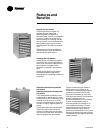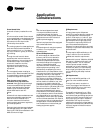
UH-PRC002-EN14
Application
Considerations
(Venting
Unit Heaters)
Power Vented Unit Heaters
Mechanically vented appliances have
enjoyed increasing acceptance in
American facilities. Power vented unit
heaters allow installation without the
need to penetrate expensive roofing
materials. They also offer more flexibility
in placement of individual unit heaters.
Mechanical venting occurs when a
power blower provides a positive air
flow to exhaust vent gas. The blower
may be mounted at the unit heater or at
the point of termination. With a factory
installed power venter, a pressure switch
detects the flow of vent gas before the
gas valve is allowed to open. With third
party drafters usually a centrifugal switch
monitors the operation of the blower
motor. When properly installed, the
switch senses motor rotation and allows
the gas valve to operate. Interlocking the
blower to the gas valve provides some
control over the combustion process.
Using a factory unit with a pressure
sensitive switch ensures that control.
With all their advantages power venters
bring some requirements as well. Each
manufacturer determines the maximum
length of pipe and fittings that his system
can use for safe operation. Remember to
count the fittings and allow for their
higher resistance to flow. The total length
of run includes not only the piping length
but the resistance of all the fittings
including the termination cap.
Many contractors have become
accustomed to using B vent with natural
draft units. Used with power vented
appliances indoors, B vent is
unacceptable. B vent does not allow
positive pressure in the vent piping to be
sealed from the heated space. Proper
installation uses 24-gauge, single wall
vent pipe and each joint sealed with
temperature resistant sealant or tape.
Power Vented Unit Heater
Vent Termination Locations
(minimum distance)


















